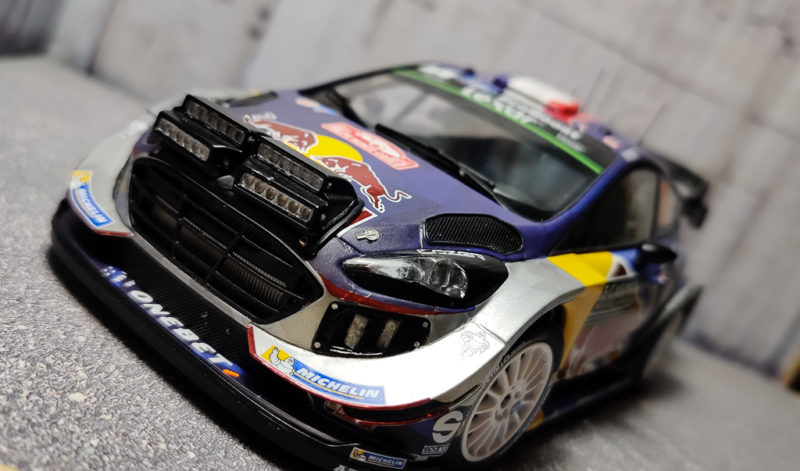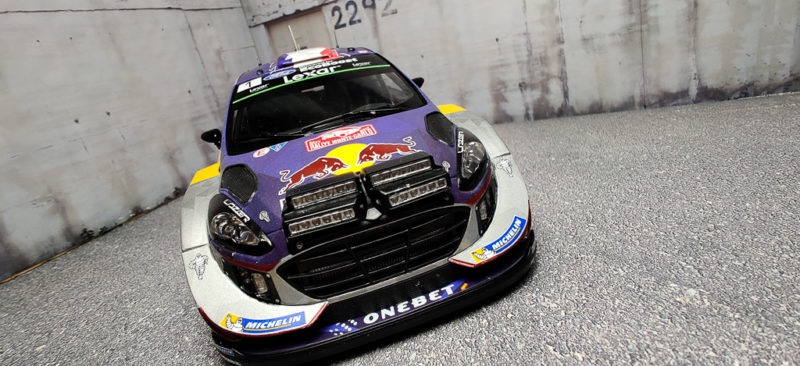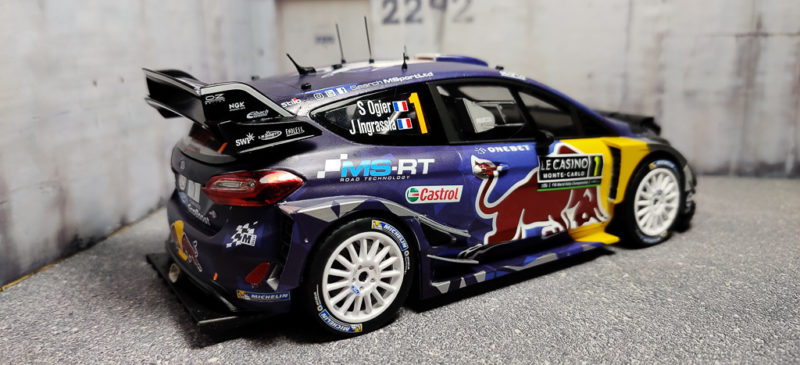Ford Fiesta WRC 2017
Title: Ford Fiesta WRC 2017
Built by: James Williams
Scale: 1/24
Kit used: Belkits BEL-012

The Model
Opening the box you are greeted by several sprue sets, one sheet of photo etch as well as a pre cut and shaped set of photo etch for the canards on the front end & mid section of the car contained within a protective plastic, also inside are the Ford logos and top aerials. The body of the car is contained in its own special box, a nice touch for keeping the body intact. Two full sized sheets of decals are included in this kit as it requires a full body wrap in differing effects ranging from matte to gloss and a chrome effect. These sheets also contain a seatbelt decal.set if you wish to keep it simple, but the kit is supplied with a long length of seatbelt material in blue for a fully photo etched seat belt and spare wheel detail. Five individual molded rubber wheels along with five rims are supplied with their own rubber pollycaps, with a few spares, the Fifth rim and tyre are for the internal spare.
The Instructions
The instructions are printed on an inkjet printed booklet and may be the weakest part of the kit. The front cover features some information about the kit as well as a handy table giving you the full list of required paints in various forms, Tamiya, Mr Hobby and Revell.
The instructions show a CAD model of the step by step process and this is where it may be a little confusing for some. Printed on white backing with some hard to work out shading on the CAD drawings it can be difficult to work out exactly where pieces need to line up. One step shows the entire internal section of the floor in one step with what appear to be two dozen or more lines pointing to different parts and colour codes.
On the final three pages are colour profile shots of the car for its livery to be applied. certain decals need to be applied in order of base coat to top coat and are relatively well structured, though the booklet does still suffer from being inkjet printed at this stage as the printing isn’t crisp.
The Build
The build was quite daunting as the decals were going to be the hardest challenge of all. This kit is definitely not a beginner level kit and is definitely a challenge.
The instructions begin with the internal part of the car, at this point I chose to work on all three main sections as they all required the base coat of gloss silver (Tamiya TS-17). The internal cockpit of the car requires a heavy amount of detail as well as some photo etch for the pedals, everything goes into place very easily with pegs shaped so you can only orient parts from one direction. The instructions for this section looked a little cluttered but after studying it started to come together after crossing applied parts off. Decals for the seat if choosing this option, instruments and rollcage all get applied here as well as the spare wheel. It was here I decided painting all five wheels would be a good choice. Belts for the spare wheel and the seats are applied, then the dashboard and rollcage afterwards. mounting the steering wheel was fairly tricky as it requires several pylons to attach to the rollcage. This section gets mounted to the chassis which is a separate piece that houses the suspension and running gear of the car, all fairly straight forward to mount together, though I would advise adding the skid plates last as they obscure the ability to mount the internals and the body which was very tricky to get together.
The body gets a coat of TS17 gloss aluminium all round after its roof mounted additions for aerials and instruments are first drilled out, drill positions are clearly included. You get a choice for the front night lights or without, I chose to go off the instructions and instead of drilling holes to permanently apply the light box, I mounted it with magnets instead to preserve the look of both options.
The decals are fairly difficult to work with, having such large decals it requires softening and a lot of work to get it to wrap the car. The first being the roof is the largest of the lot and took a lot of care. I would not recommend this kit for this reason to anyone that is new to modelling.
After layering the various decals with a softening solution all round the windows and clear parts go in, all fairly simple though some fitment issues with them requiring some persuasion.
Finally the body shell is mounted onto the chassis using the pegs at the front and rear of the body shell. Again, I recommend leaving the skid plates under the car off until the shell goes on to make this process easier.
Overall a very challenging build, for me as an intermediate builder of only a year it was my greatest challenge to date and I recommend it to someone with a little experience with both photo etch and applying decals. Decal solution is recommended for this process though you must keep in mind some of the decals need to remain matte so keep an eye on the micro set.
© Model, photographs and text, James Williams
Pros:
Massively detailed interior and exterior
Very few mold lines and cleanup
Varying materials such as Photo Etch, cloth belts and rubber parts.
Top quality decals
Cons:
Confusing instruction diagrams
Poorly printed instructions
Some locating pins not large enough to provide good hold of parts.
Decals may be too difficult for new builders.







